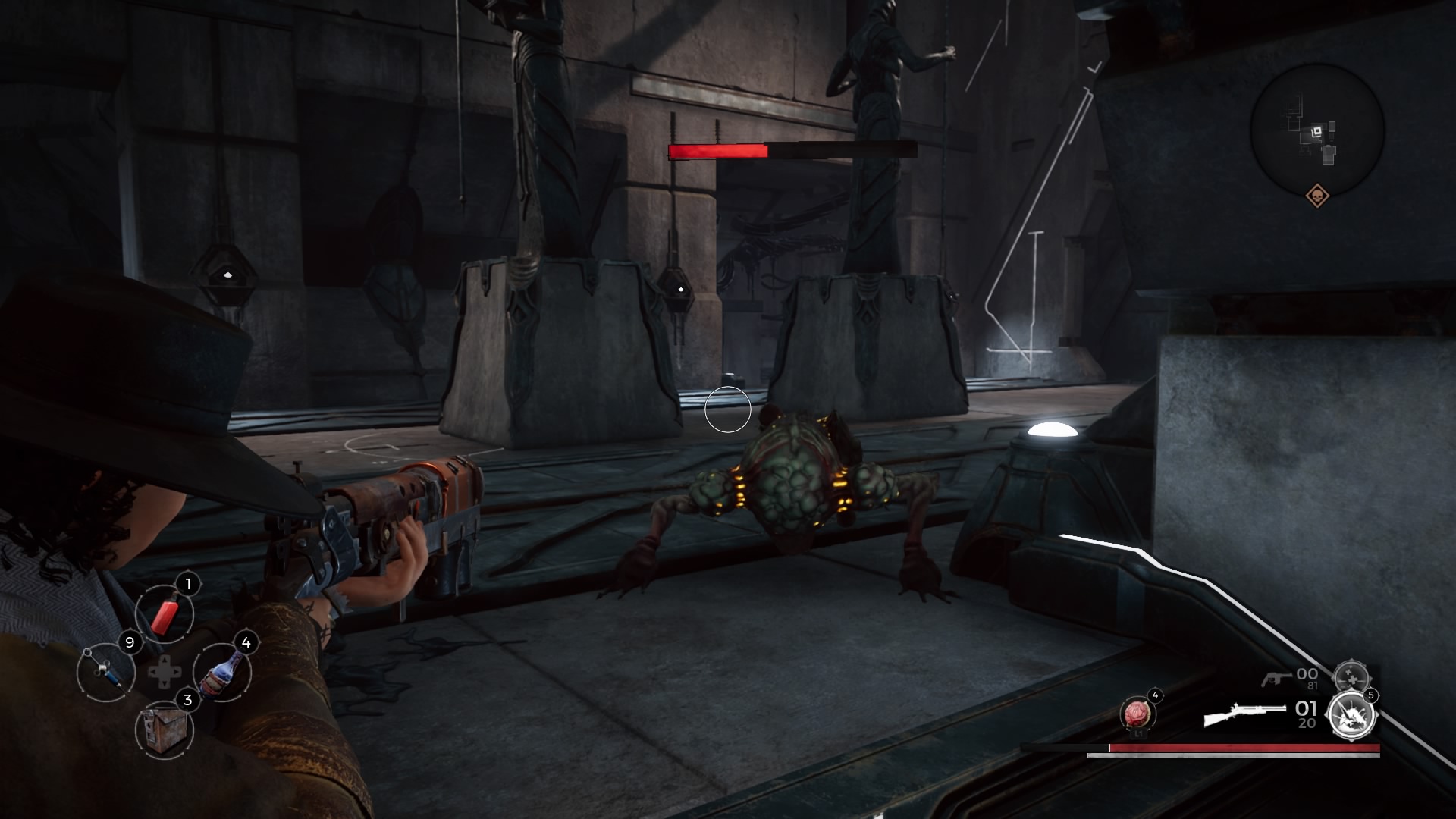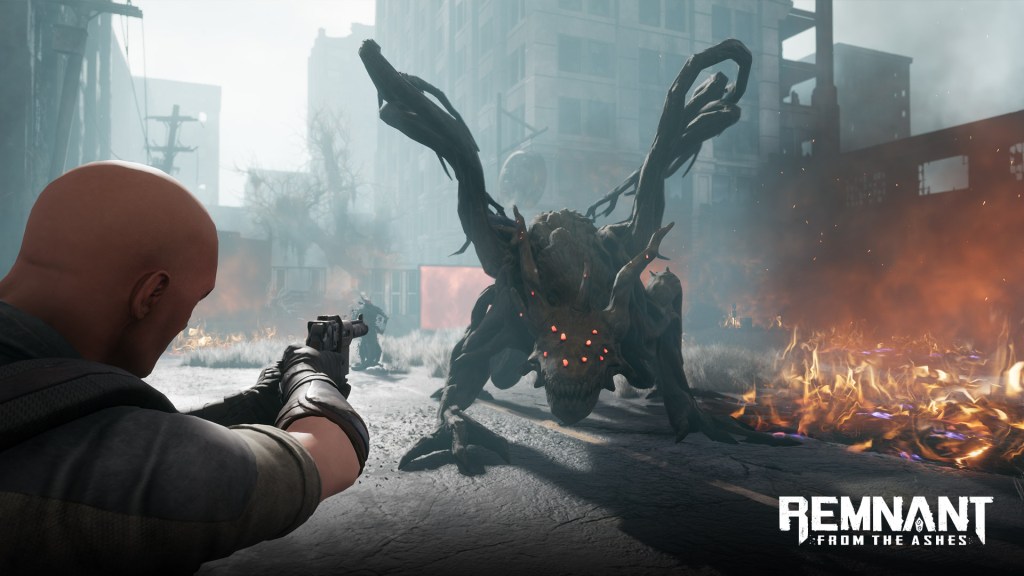Gunfire Games makes no effort to hide all of the influences in Remnant: From the Ashes. In fact, It’s a game that rests on the idea that you’ve played several of those games before. There’s a familiarity in some of its tropes that extend just close enough to “repetitive” to keep you engaged. Then, in almost every way it can, Remnant subverts your expectations.
At some point, the world was thrown into a dark after of chaos thanks to The Root. This aggressive, supernatural threat has turned Earth’s trees and plant life into twisted beasts. The humans that survived, including you, barely remember a world before all of this. Some of you are determined to see one after.

This grim vision of Earth seems much like the junk punk of Fallout 4 or Metro: Exodus. Old, somewhat recognizable tech like cars and high-rise buildings spot streets that have been reclaimed by giant trees and vines. The sorts of people you meet are the kind you expect out of these games, too. Groups of violent scavengers raid the neighborhoods. Hardened vets sacrifice sleep in order to keep their communities together. So on and so forth.
The Root of the Issue
But every once in a while, you’ll find some inspired nuances to these archetypes. Old Mudtooth, a hermit who sings to himself, will sell you his prized stew if you want. If you stick around and let him tell you his stories, you’ll find some well written, well acted moments full of humor and heartache. Be it through innocuous NPCs, or a random journal entry, Remnant finds a way to tell unique and affecting stories in a genre that has seemed to run out of new ways to do so.

The apocalypse itself feels more mysterious and foreboding than any recent game in memory. Gunfire Games makes The Root both a literal threat, and also an existential one, especially after they pull the veil back on the real scope of their tyranny. Once you start hopping across worlds, you really see this game as something more ambitious than your standard disaster fiction.
For example, one would expect that battling The Root across worlds means battling brutal tree demons across differently flavored locales. But in one desert world, for example, you don’t see The Root at all. Instead, you spend most of your time contending with a world that was touched by their scourge, but ultimately survived it. The cost of survival, as shone in the shapes and actions of this world’s people, is its own sort ludonarrativeity. One that repeats over the course of your play through, and is almost always successful.

Heartwood and Souls
Remnant has spent a lot of its early moments on the internet being called a Souls-like. Dungeon-delving, bonfire-equivalent safe stations, and limited-use healing items don’t push back much on this labeling. However, Remnant has some very important differences that really push it into a class of its own.
The worlds you explore all get procedurally generated the first time you load them. This means that everyone’s trip through a world can play out remarkably different. The bosses you fight, the order in which you fight them, and sometimes even whole quests or areas will be different from play-through to play-through. This can make exploring areas feel somewhat dynamic, especially if you are joining a friend or random players via co-op.

But enemies and layouts being so random also removes the puzzle solving aspect of traversing a zone in Dark Souls. In Souls, with everything being hand placed, and the same threats returning to the same spaces on the map every time, you can eventually learn the language of a particularly troublesome area through trial and error. While a dungeon’s map may stay the same after a death, the enemies – and specifically the sub-bosses – that prowl the area may not show up in the same place, or even be the same enemy.
Kick Aspen
Another big and obvious difference is the combat. Often called “Souls with guns,” it might be better served being called “Resident Evil if Umbrella won.” That third person, over the shoulder approach to gunplay is faster and more kinetic. But when you really get in the groove, Remnant starts to feel like a high scoring run in the old RE shoot-em up mini-game; Mercenaries, in all the best ways.

Big boss fight are often elevated by the locales they take place in. Some are in big arenas full of destructible cover and buildings. My favorites tend to take place not just in one room, but in snaking complexes where outrunning bosses and re-positioning for the best advantages are just as important as using the strongest weapons that will do the most damage.
Melee combat feels like an afterthought, though. It’s largely just something you use when reloading will take too much time. This isn’t the worst thing, since the game’s shooting is done so well, but the pool to do anything besides shooting the bad guys is shallow.

Strange Fruit
The amount of gear you acquire to customize your character with may leave some folks wanting. The scarcity of unique weapons and armor in Remnant is more reminiscent of Bloodborne. Unlike Bloodborne, the differences between each weapon are way less clear. Your guns cover all the shooter staples – pistols, rifles, shotguns, etc. – but outside the rare gear that can be crafted after slaying bosses, very few of them stand out as better or worse than others in specific situations. You’re better off just upgrading your favorite and sticking with it.
Mods really spice guns up. After charging them up by using the gun they’re assigned to, they provide you with strong, on use abilities. One turns your gun’s rounds into area of effect explosives. Another lets you see enemies through walls and do more critical hit damage to them. As you find more ways to make mods, either as quest rewards or with boss trophies, the kinds of cool loadouts you can mix and match with online partners can really be cool.

My favorite feature of customization are traits. Each trait is usually a stat buff that you can put trait points in. You earn trait points with experience, which you gain by killing foes and completing quests. You can earn traits themselves in a surprising number of ways. Sometimes, they are boss or quest rewards. Other Times, you get them by hitting some milestones, like collecting a certain amount of weapons. I’ve gotten traits by being killed by my allies in multiplayer, or finding secrets. I love this sort of motivation to try weird things. It’s a meta layer of interaction akin Achievement Points or Trophies, but supplies some in-game benefit, and not just cosmetic bragging rights.
Forest Fire
The multiplayer is a hit-or-miss experience. Running and gunning through sewers and tombs with the lads is a blast. As soon as other players join your world, everything will scale up in difficulty. Problematically, players don’t seem to load in instantly, even if the life and damage buffs all the monsters get registered immediately. This could mean that if your game is open to the public, someone who’s loading in could suddenly make a challenging room into an unwinnable crucible unbeknownst to them.

The most frustrating part of co-op is that any player can completely take over any dialogue section you run into. At best, this could mean that a lonely NPC sitting in a room in a dungeon by themselves might tell you some interesting, context-less facts about your surroundings. At worst, it means that instead of getting a chance to talk an enemy and his gang down from violence, you get thrust into a raucous shoot out through no fault of your own. It’s a huge bummer to watch potentially interesting story moments get thrown away by some random in your party.
At a budget price and launching with a last minute ad bumrush, Remnant: From the Ashes is the kind of title you’d expect to come out and vanish quickly. But for fans of tough RPGs, action shooters, or post-apocalyptic fiction, passing up on Remnant would be a devastating mistake. It easily joins the ranks of games like Vampyr, that stubbornly outgrow their financial constraints to truly innovate and elevate a genre that has long since needed new ideas.
Remnant From the Ashes review code provided by publisher. Reviewed on a PS4. For more information, please read our Review Policy.
-
Unique post-apocalypse story telling
-
Excellent gunplay
-
Engaging traits system
-
Limited gear selection
-
Hit-or-miss multiplayer




